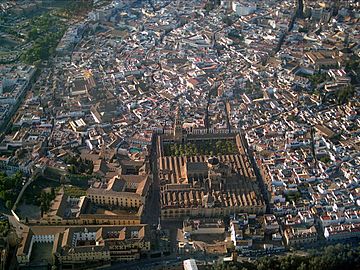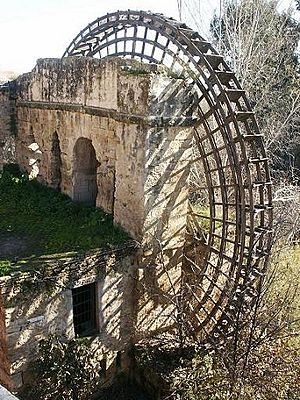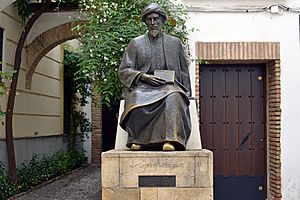Historic centre of Córdoba facts for kids
Quick facts for kids UNESCO World Heritage Site |
|
|---|---|
 |
|
| Location | Córdoba, Andalusia, Spain |
| Includes | Cathedral of Córdoba, Roman bridge of Córdoba, Calahorra Tower, Alcázar de los Reyes Cristianos, San Basilio, Córdoba, Roman walls of Córdoba, Caliphal Baths, Episcopal Palace of Cordoba, San Sebastián Hospital |
| Criteria | Cultural: (i), (ii), (iii), (iv) |
| Inscription | 1984 (8th Session) |
| Extensions | 1994 |
The historic centre of Córdoba in Spain is one of Europe's largest and oldest city centers. In 1984, UNESCO recognized the amazing Mosque–Cathedral of Córdoba as a World Heritage Site. Ten years later, they added a large part of the old town to this special list. This historic area is full of old buildings and monuments. They show us many signs of Roman, Arabic, and Christian times.
Contents
A Look Back: Córdoba's History
From Romans to Moors
Córdoba started as a town built by the Carthaginians. The Romans took control in 206 BC. It soon became an important capital in the Roman province of Hispania Citerior. The city had beautiful buildings and strong walls.
In the 6th century, the Roman Empire began to fall apart. The city then came under the rule of the Visigoths. This lasted until the early 8th century. That's when the Moors (Muslim people from North Africa) conquered it.
The Golden Age of al-Andalus
By 716, Córdoba was a provincial capital. In 766, it became the capital of the Muslim emirate of al-Andalus. By the 10th century, Córdoba was known as the Caliphate of Córdoba. It was one of the most advanced cities in the world. People admired it for its culture, learning, and religious tolerance. The city had a huge library. It also had over 300 mosques and many palaces.
Christian Rule and New Growth
In 1236, King Ferdinand III took the city back for the Christians. He built new defenses. He also changed the Grand Mosque into a cathedral. The Christian city grew around this new cathedral. It added palaces, churches, and a fortress. Even though Córdoba lost some political power under Christian rule, it stayed important for trade. This was thanks to the copper mines nearby in the Sierra Morena mountains.
Where is the Historic Centre?
The historic centre, as defined by UNESCO, includes all the old buildings and narrow, winding streets around the cathedral.
- To the south, it reaches the River Guadalquivir. This includes the famous Roman Bridge and the Calahorra Tower.
- To the east, it is bordered by Calle San Fernando.
- To the north, it touches the modern shopping area.
- To the west, it includes the Alcázar and the San Basilio district.
Important Monuments and Buildings
Córdoba's historic centre is like a living museum. You can see buildings from different times.
Roman Era Remains
You can still see signs of the Roman period today:
- The 16-arch bridge crosses the Guadalquivir river.
- Beautiful mosaics are found in the Alcázar.
- Columns from the Roman temple still stand.
- Parts of the old Roman walls can be seen.
Moorish and Jewish Influences
The Caliphal Baths show Moorish design. The gardens of the Alcázar, next to the former Grand Mosque, also show this influence. Some old minarets (towers where Muslims are called to prayer) from this time are now part of Christian churches. You can find them in the churches of Santiago, San Lorenzo, San Juan, and the Santa Clara Hermitage.
The Jewish community also lived here during Muslim rule. The La Judería district shows their presence. The synagogue in this area was used until 1492.
Christian Era Buildings
- The Alcázar was first a Moorish castle. In the 14th century, it became a home for Christian kings.
- The Calahorra Tower was built by the Almohads. King Henry II rebuilt it in 1369.
- The small Chapel of San Bartolomé was finished in 1410. It shows a mix of Gothic and Mudéjar styles.
- The former San Sebastián Hospital was completed in 1516. It is now the Congress Centre. It combines Gothic, Mudéjar, and Renaissance styles.
- Other churches from this time include San Nicolás and San Francisco.
Later Additions
Many important buildings were built in the 16th century. These include the San Pelagio Seminary and the Puerta del Puente. The Palacio del Marqués de la Fuensanta del Valle was designed by Hernán Ruiz. The 18th-century Hospital del Cardenal Salazar is also notable for its beautiful Baroque front.
Other historic places include the Episcopal Palace. It was built on the remains of an old Visigoth palace. Today, it is the Diocesan Fine Arts Museum. The Royal Stables were built by King Philip II in 1570. They were part of the Alcázar complex.
Jewish Cordoba
Córdoba was a very important place for Jewish life in Andalusia for many centuries. One of the most famous medieval Rabbis, the Rambam (also known as Maimonides), lived here. There is a historic Jewish Quarter from the Middle Ages. It has one of the oldest synagogues in the world, the Cordoba synagogue, built in 1325.
Gallery
See also
 In Spanish: Centro histórico de Córdoba para niños
In Spanish: Centro histórico de Córdoba para niños

















